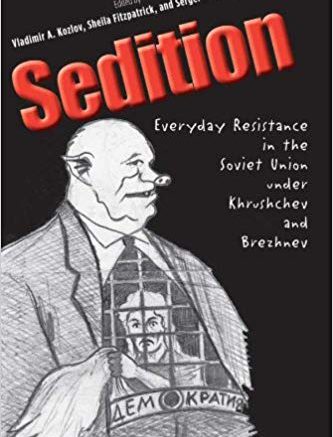‘Sedition – Everyday resistance in the Soviet Union under Khrushchev and Brezhnev’ – Authored by Vladimir A Kozlov, Sheila Fitzpatrick, Sergei V Mironenko, O.V Edelman, Olga Livshin, E.Iu. Zavadskaia and the Russian Federation State Archive
ISBN-13 978-0300111699 – Published by Yale University Press – 394 pages
‘Sedition’ is a magnificent book. It tells, via police, internal security and court records, the story of the small acts of resistance against the post-Stalin Soviet governments of Khrushchev and Brezhnev. This book also speaks of the punishments that were brought down upon many dissidents by the government of the Soviet Union.
For much of my life, or at least during the Cold War part of it, the Soviet Union was to a large extent an unknown but baleful presence. Many of us, even those of us who were on the Left at the time, knew that the Soviet Union was not a free country and we laughed at and poured scorn on the ‘Tankies’ of the pro-Soviet Left that still held up the Soviet Union as a glowing ‘example of a worker’s state’.
Many of us, especially those of us who were less doctrinaire than the Tankies, understood that we could protest in London but those in Leningrad were denied similar rights to protest or express their views. That showed us quite clearly the difference between the free societies of the West and the decidedly unfree society created by Soviet-style Communism.
Although many who lived through the Cold War, whether they were on the left or the right of the political spectrum, knew that the Soviets were a threat and the country was run on oppressive lines, we did not get the fine detail about life in the Soviet Union. Yes of course we heard about the stories of the big dissidents who got massive press coverage, We heard of Alexander Solzhenitsyn who survived the Gulags, Andrei Sakharov who never lived long enough to see Russia finally free of Communism and others such as the ballet dancer Rudolf Nureyev, who defected to the free world. But there was a gap in our knowledge here in the West during the Cold War and that was that we knew very little about the lives of the ordinary people who resisted Communism or what happened to such resisters.
With the publication of ‘Sedition’, which came out in 2011, many of the gaps in knowledge that we had about the fate of smaller scale and less well known dissidents, have been filled in. ‘Sedition’ teaches us us about the small acts of rebellion that disgruntled Soviet citizens undertook. This sort of resistance took the form of anything from individuals distributing anonymous letters in their immediate area, along with drunken rants about Soviet ‘heroes’ such as Stalin, non compliance with government orders and vandalism against symbols of the Soviet state. Resistance, of a more intellectual kind was undertaken by various Communist ‘true believers’ who wished Communism to be reformed. Some of these resisters were harshly punished with prison terms and loss of jobs, others knuckled down under the pressure from the state and ‘reformed’. However, the punishments that were meted out to dissidents, although unjust, harsh and quite representative of how unfree nations conduct themselves, were much less harsh than in the days of Stalin. Under the rule of Stalin’s heirs, the people imprisoned by Communism in the Soviet Union no longer had to fear as much that possession of the wrong book or wrong pamphlet or wrong opinion would cause them to die violently or be shipped off to the Gulags. After the death of the monster that was Stalin, the people of the Soviet Union started to slowly shake off the fear of imminent death or imprisonment at the hands of a capricious tyrant. The people of the Soviet Union started to speak to one another, and try to exchange ideas and thoughts although this was still something punishable as ‘anti Soviet propaganda’.
Although under Khrushchev and Brezhnev the more violently oppressive aspects of Communism started to be rolled back, the Soviet Union was never truly free. It was still under the yoke of Communism after all.
The beauty of ‘Sedition’ is it shows many of the stories of disgruntled Soviet citizens that may have previously been overlooked. ‘Sedition’ does this by way of police and prosecutor reports from the Russian State Archive. Through the contemporaneous eyes of police officers and prosecutors, along with the words of dissidents themselves, we get some inkling of what life was like for a Soviet citizen who had the temerity to say ‘no’ to the Communists or Communist ideas.
This is a superb book and a very valuable resource for anyone who wants to know what what it was like to live in a totalitarian state, a state without many of the freedoms that we all too often take for granted here in the West, and especially in the USA. The team of authors behind ‘Sedition’ have produced for us a fabulously detailed account of the actions of lower level Soviet dissidents and they have done so using primary sources such as police and other government records.
The authors of ‘Sedition’ quite rightly point out that although the monolithic view that the Soviet Union was murderously oppressive all the time is mistaken, after Stalin things got easier. But, the Soviet citizen although more free than before, was still living in a state that was paranoid about political heresy and punished it when they could.
It is this depiction of a government hell-bent on eradicating political heresy, something that comes over throughout the book, which caused me to think about what it would be like to live in a society where hunting political heretics was a priority for the police. Who would ever honestly want to say they would want to live in a society dominated by political heresy hunters? Such as society is a frightening prospect for where there are heresy hunters there are those who gain advantage by denouncing heresy.
I would strongly advise anyone interested in the history of the Soviet Union and of the various types of resistance to it to get hold of a copy of this book. It is available on Amazon but the paperback is considerably cheaper than the hardback. I got my copy of the hardback from a book discounter a few years back and it has become one of those book purchases that I am very glad I made. I thoroughly recommend this book, it’s a corker of a modern history book.





